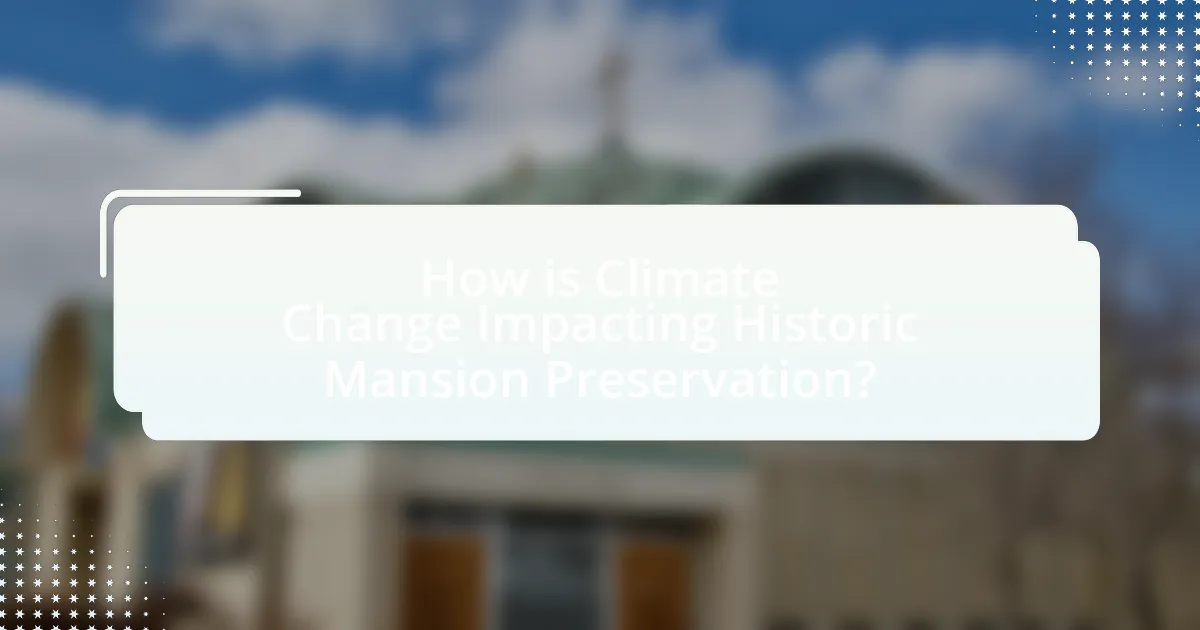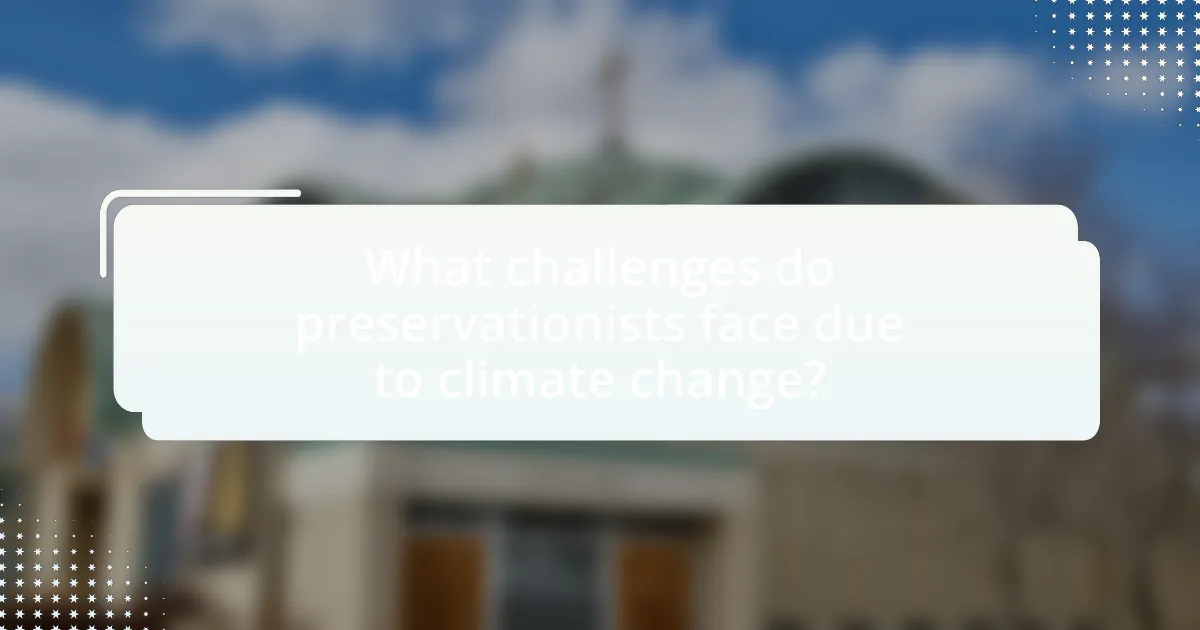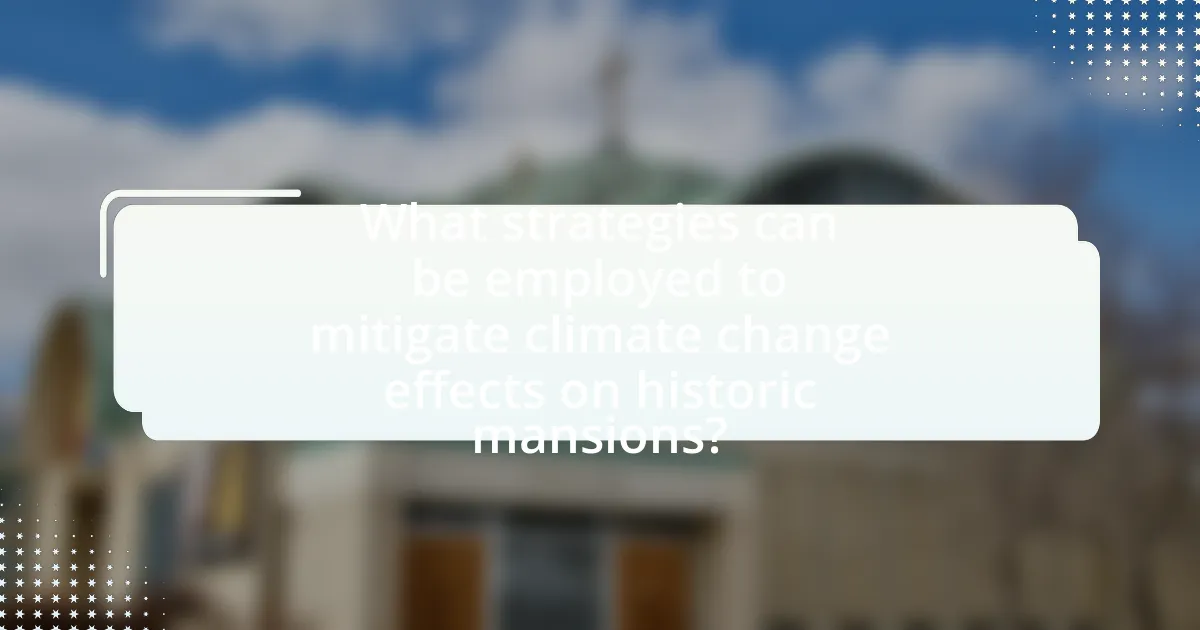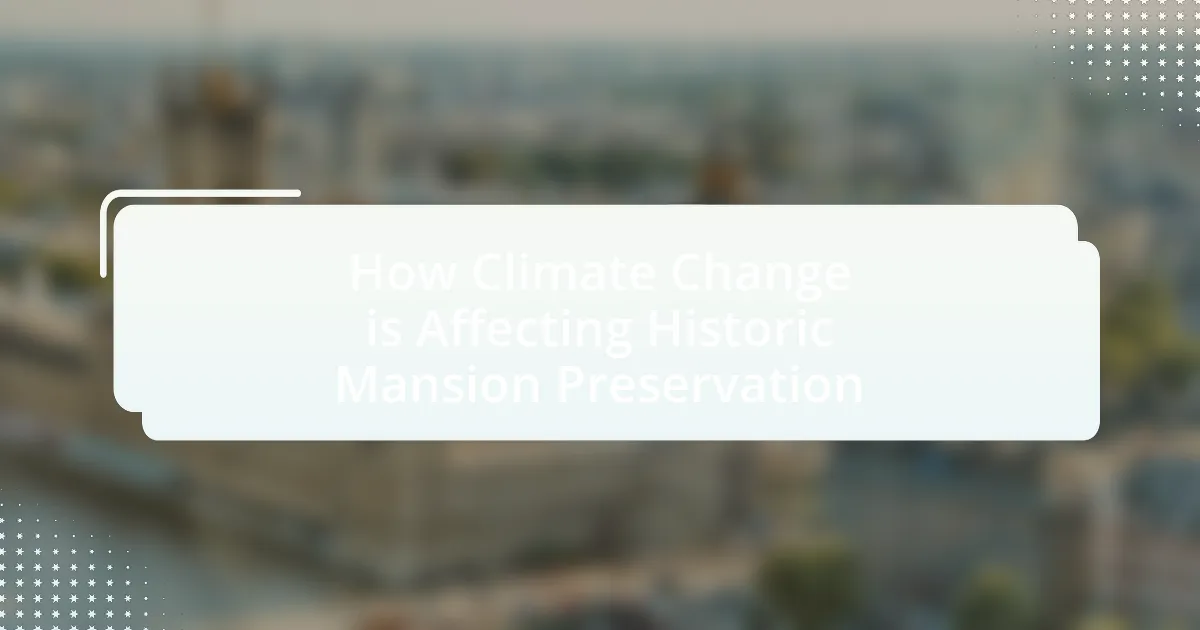Climate change is significantly impacting the preservation of historic mansions, leading to increased risks of flooding, structural damage from extreme weather events, and accelerated deterioration of building materials. Rising sea levels and temperature fluctuations threaten the integrity of these structures, while increased humidity promotes mold growth and corrosion. The article explores the cultural significance of historic mansions, their economic contributions through tourism, and the challenges preservationists face due to climate change. It also discusses strategies for mitigating these effects, including the use of modern technology, innovative materials, and community engagement in preservation efforts.

How is Climate Change Impacting Historic Mansion Preservation?
Climate change is significantly impacting historic mansion preservation by increasing the frequency and intensity of extreme weather events, which can lead to structural damage and deterioration. For instance, rising sea levels threaten coastal mansions, while increased rainfall can cause flooding and mold growth, compromising the integrity of building materials. According to the National Trust for Historic Preservation, properties in flood-prone areas face heightened risks, necessitating costly repairs and adaptations. Additionally, temperature fluctuations can accelerate the decay of wood and other materials used in historic construction, further complicating preservation efforts.
What are the primary effects of climate change on historic mansions?
The primary effects of climate change on historic mansions include increased risk of flooding, structural damage from extreme weather events, and deterioration of building materials. Flooding can lead to water damage, mold growth, and compromised foundations, particularly in coastal areas where rising sea levels are a concern. Extreme weather events, such as hurricanes and heavy storms, can cause significant physical damage to roofs, windows, and facades. Additionally, climate change accelerates the deterioration of materials like wood and stone due to increased humidity and temperature fluctuations, which can undermine the integrity of these historic structures.
How do rising temperatures affect the structural integrity of these buildings?
Rising temperatures negatively affect the structural integrity of historic buildings by causing materials to expand and contract, leading to stress and potential damage. For instance, wood can warp and crack, while masonry may experience increased cracking due to thermal expansion. Research indicates that prolonged exposure to higher temperatures can accelerate the deterioration of building materials, compromising their load-bearing capacity and overall stability. A study published in the journal “Building and Environment” highlights that temperature increases can lead to significant structural failures in older buildings, emphasizing the urgent need for preservation strategies that account for climate change impacts.
What role does increased humidity play in the deterioration of historic materials?
Increased humidity accelerates the deterioration of historic materials by promoting mold growth, corrosion, and structural damage. High moisture levels can lead to the breakdown of organic materials, such as wood and textiles, as they become susceptible to fungal infestations and insect activity. For instance, studies have shown that wood can absorb moisture, leading to swelling, warping, and eventual decay, while metals can corrode more rapidly in humid environments. The National Park Service has documented that maintaining relative humidity levels between 30% and 50% is crucial for the preservation of historic artifacts, as deviations can significantly shorten their lifespan.
Why is it important to preserve historic mansions in the face of climate change?
Preserving historic mansions is crucial in the face of climate change because these structures embody cultural heritage and historical significance. Historic mansions serve as tangible connections to the past, reflecting architectural styles, craftsmanship, and societal values of their time. According to the National Trust for Historic Preservation, preserving these buildings can enhance community identity and promote tourism, which contributes to local economies. Furthermore, historic mansions often utilize sustainable building practices and materials that can inspire modern construction methods, thereby reducing environmental impact. By maintaining these properties, communities can safeguard their history while also promoting resilience against climate change effects, such as extreme weather events that threaten their structural integrity.
What cultural significance do historic mansions hold for communities?
Historic mansions hold significant cultural value for communities as they serve as tangible links to local history and heritage. These structures often embody architectural styles and craftsmanship reflective of the era in which they were built, contributing to a community’s identity and sense of place. For instance, many historic mansions are associated with prominent figures or events that shaped the region, thus fostering a collective memory and pride among residents. Furthermore, they often serve as venues for cultural events, educational programs, and tourism, which can enhance community engagement and economic development. The preservation of these mansions is crucial, as they not only represent historical narratives but also contribute to the aesthetic and cultural landscape of the community.
How do historic mansions contribute to local economies?
Historic mansions contribute to local economies primarily through tourism, which generates revenue and creates jobs. These properties often attract visitors interested in history, architecture, and culture, leading to increased spending in local businesses such as hotels, restaurants, and shops. For instance, a study by the National Trust for Historic Preservation found that heritage tourism can generate up to $4.2 billion annually in the United States alone. Additionally, the preservation and maintenance of these mansions create employment opportunities in restoration, hospitality, and education sectors, further bolstering the local economy.

What challenges do preservationists face due to climate change?
Preservationists face significant challenges due to climate change, primarily including increased weather-related damage, rising sea levels, and temperature fluctuations. These factors lead to accelerated deterioration of historic structures, as extreme weather events such as hurricanes and floods can cause immediate and severe damage. For instance, the National Trust for Historic Preservation reports that historic sites in coastal areas are increasingly threatened by rising sea levels, which can submerge properties and erode foundations. Additionally, temperature fluctuations can lead to structural issues, such as wood rot and mold growth, compromising the integrity of buildings. These challenges necessitate adaptive strategies and increased funding for preservation efforts to mitigate the impacts of climate change on historic mansions.
How does extreme weather impact preservation efforts?
Extreme weather significantly hinders preservation efforts by causing physical damage to historic structures and increasing maintenance costs. For instance, heavy rainfall can lead to flooding, which damages foundations and interiors, while extreme heat can cause materials like wood and plaster to warp or crack. According to a report by the National Trust for Historic Preservation, climate-related events have resulted in billions of dollars in damages to historic properties, underscoring the urgent need for adaptive preservation strategies.
What types of extreme weather events are most damaging to historic mansions?
Extreme weather events that are most damaging to historic mansions include hurricanes, floods, and severe storms. Hurricanes can cause significant structural damage due to high winds and flying debris, while flooding can lead to water damage, mold growth, and deterioration of building materials. Severe storms often result in heavy rainfall and hail, which can erode facades and damage roofs. According to the National Trust for Historic Preservation, properties in coastal areas are particularly vulnerable, with studies indicating that flooding from storm surges has increased in frequency and intensity due to climate change.
How can preservationists prepare for and respond to these events?
Preservationists can prepare for and respond to climate change events by implementing adaptive management strategies that include risk assessments, emergency response plans, and sustainable practices. These strategies involve evaluating the vulnerabilities of historic mansions to climate-related threats such as flooding, extreme temperatures, and storms. For example, the National Trust for Historic Preservation emphasizes the importance of conducting climate vulnerability assessments to identify specific risks to properties. Additionally, preservationists can develop emergency response plans that outline procedures for protecting structures during extreme weather events, ensuring that resources are allocated effectively. Sustainable practices, such as using climate-resilient materials and improving drainage systems, can also mitigate damage and enhance the longevity of historic structures.
What financial implications arise from climate change for preservation projects?
Climate change leads to increased financial burdens for preservation projects due to rising maintenance costs, damage from extreme weather events, and the need for retrofitting structures to withstand climate impacts. For instance, historic mansions may require enhanced drainage systems or climate-resilient materials, which can significantly elevate renovation expenses. Additionally, studies indicate that properties in flood-prone areas may experience a decrease in market value, further complicating funding for preservation efforts. According to the National Trust for Historic Preservation, climate change could result in a 20% increase in preservation costs over the next few decades, highlighting the urgent need for financial planning in the face of these challenges.
How do increased restoration costs affect funding for preservation?
Increased restoration costs negatively impact funding for preservation by diverting financial resources away from other critical preservation projects. As restoration expenses rise, organizations and governments may struggle to allocate sufficient funds, leading to prioritization of projects based on available budgets. For instance, a report from the National Trust for Historic Preservation indicates that rising costs due to climate change-related damage can lead to a 20-30% increase in restoration budgets, which forces many preservation initiatives to be postponed or canceled altogether. This financial strain ultimately hampers the ability to maintain and protect historic sites effectively.
What are the long-term economic impacts of neglecting preservation due to climate change?
Neglecting preservation due to climate change leads to significant long-term economic impacts, including decreased property values and increased restoration costs. As historic mansions deteriorate from climate-related damage, their market appeal diminishes, resulting in lower real estate prices. For instance, a study by the National Trust for Historic Preservation found that properties in areas vulnerable to climate change can lose up to 30% of their value over time. Additionally, the costs associated with restoring neglected properties escalate as structural damage worsens, often requiring more extensive and expensive repairs. This cycle of decline not only affects individual property owners but also reduces local tax revenues and can lead to broader economic downturns in communities reliant on heritage tourism.

What strategies can be employed to mitigate climate change effects on historic mansions?
To mitigate climate change effects on historic mansions, strategies such as retrofitting for energy efficiency, implementing sustainable landscaping, and utilizing climate-resilient materials can be employed. Retrofitting involves upgrading insulation, windows, and HVAC systems to reduce energy consumption and improve climate resilience. Sustainable landscaping, including native plant gardens and permeable surfaces, helps manage stormwater and reduces heat islands. Additionally, using climate-resilient materials, such as those that withstand extreme weather, preserves the structural integrity of these historic buildings. These strategies are supported by studies indicating that energy-efficient upgrades can reduce energy use by up to 30%, while sustainable landscaping can significantly lower maintenance costs and enhance biodiversity.
How can modern technology aid in the preservation of historic mansions?
Modern technology aids in the preservation of historic mansions through advanced monitoring systems, climate control, and restoration techniques. For instance, sensors can detect changes in temperature and humidity, allowing for timely interventions to prevent damage from moisture or temperature fluctuations. Additionally, 3D scanning and modeling technologies enable precise documentation of architectural features, facilitating accurate restorations. Furthermore, materials science advancements provide innovative solutions for repairing and reinforcing structures without compromising historical integrity. These technologies collectively enhance the ability to maintain and protect historic mansions against the impacts of climate change.
What innovative materials can be used to enhance resilience against climate change?
Innovative materials that can enhance resilience against climate change include bio-based composites, self-healing concrete, and phase change materials. Bio-based composites, made from natural fibers and resins, offer sustainable alternatives to traditional materials, reducing carbon footprints and improving energy efficiency in buildings. Self-healing concrete incorporates bacteria that can repair cracks autonomously, extending the lifespan of structures and minimizing maintenance costs. Phase change materials can absorb and release thermal energy, helping to regulate indoor temperatures and reduce energy consumption. These materials have been validated through various studies, demonstrating their effectiveness in improving building resilience in the face of climate change challenges.
How can climate modeling assist in preservation planning?
Climate modeling can assist in preservation planning by providing data on future climate scenarios that affect historic mansions. This data enables planners to identify potential risks such as increased flooding, temperature fluctuations, and extreme weather events that could damage these structures. For instance, a study by the National Park Service indicates that climate models predict a 30% increase in heavy precipitation events in certain regions, which directly impacts the structural integrity of historic buildings. By integrating climate modeling into preservation strategies, stakeholders can prioritize interventions, allocate resources effectively, and implement adaptive measures to safeguard these cultural assets against climate change impacts.
What best practices should preservationists adopt to protect historic mansions?
Preservationists should adopt a multi-faceted approach that includes regular maintenance, climate-responsive renovations, and the use of sustainable materials to protect historic mansions. Regular maintenance involves inspecting and repairing structural elements, roofs, and windows to prevent deterioration caused by weather conditions. Climate-responsive renovations should focus on improving energy efficiency while maintaining historical integrity, such as installing insulation that does not alter the building’s appearance. Additionally, using sustainable materials helps mitigate environmental impact and ensures that repairs are in line with preservation standards. These practices are essential as they address the challenges posed by climate change, which can accelerate the degradation of historic structures.
How can regular maintenance help mitigate climate-related damage?
Regular maintenance can significantly mitigate climate-related damage by ensuring that historic mansions remain structurally sound and resilient against environmental stressors. Consistent upkeep, such as inspecting roofs, sealing windows, and maintaining drainage systems, prevents water infiltration and structural deterioration caused by extreme weather events. For instance, a study by the National Trust for Historic Preservation indicates that regular maintenance can extend the lifespan of historic buildings by up to 50%, thereby reducing the frequency and severity of climate-related repairs. This proactive approach not only preserves the architectural integrity of these structures but also minimizes the overall impact of climate change on their preservation.
What role do community engagement and education play in preservation efforts?
Community engagement and education are crucial in preservation efforts as they foster local stewardship and awareness of cultural heritage. Engaging the community encourages individuals to take an active role in protecting historic sites, which is essential in the face of climate change threats. For instance, educational programs can inform residents about the specific impacts of climate change on historic mansions, such as increased flooding or temperature fluctuations, thereby motivating them to participate in preservation initiatives. Studies have shown that communities with strong educational outreach are more likely to support and engage in preservation activities, leading to more sustainable outcomes for historic sites.
What practical steps can individuals take to support historic mansion preservation?
Individuals can support historic mansion preservation by actively participating in local preservation organizations and initiatives. Engaging with these groups allows individuals to contribute to fundraising efforts, volunteer for restoration projects, and advocate for policies that protect historic sites. For instance, the National Trust for Historic Preservation reports that grassroots efforts have successfully saved numerous historic properties through community involvement and awareness campaigns. Additionally, individuals can educate themselves and others about the significance of these mansions, fostering a culture of appreciation that can lead to increased support for preservation efforts.

Leave a Reply